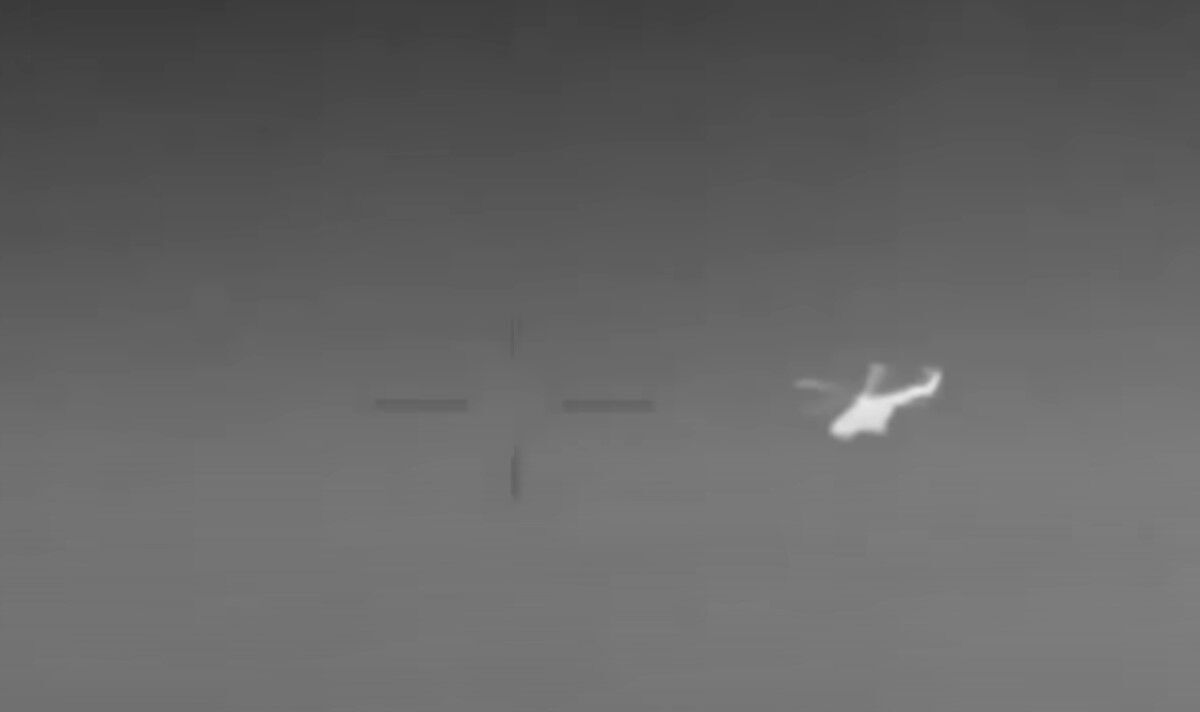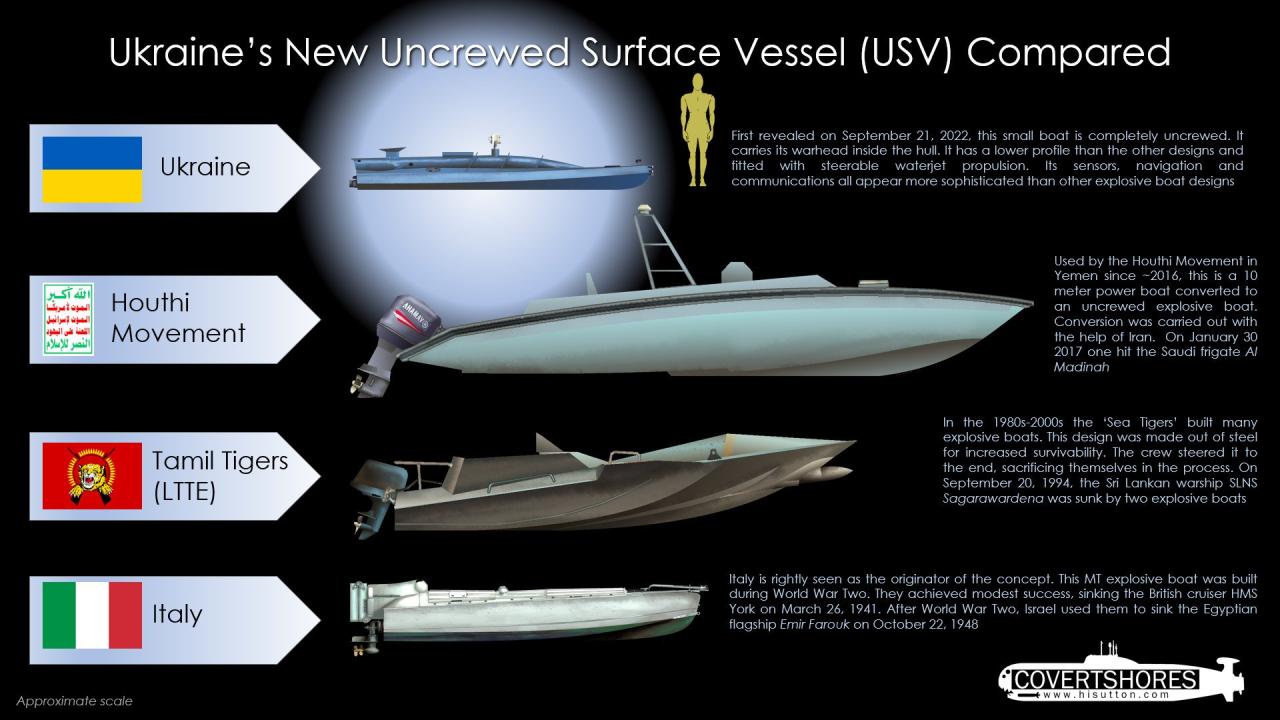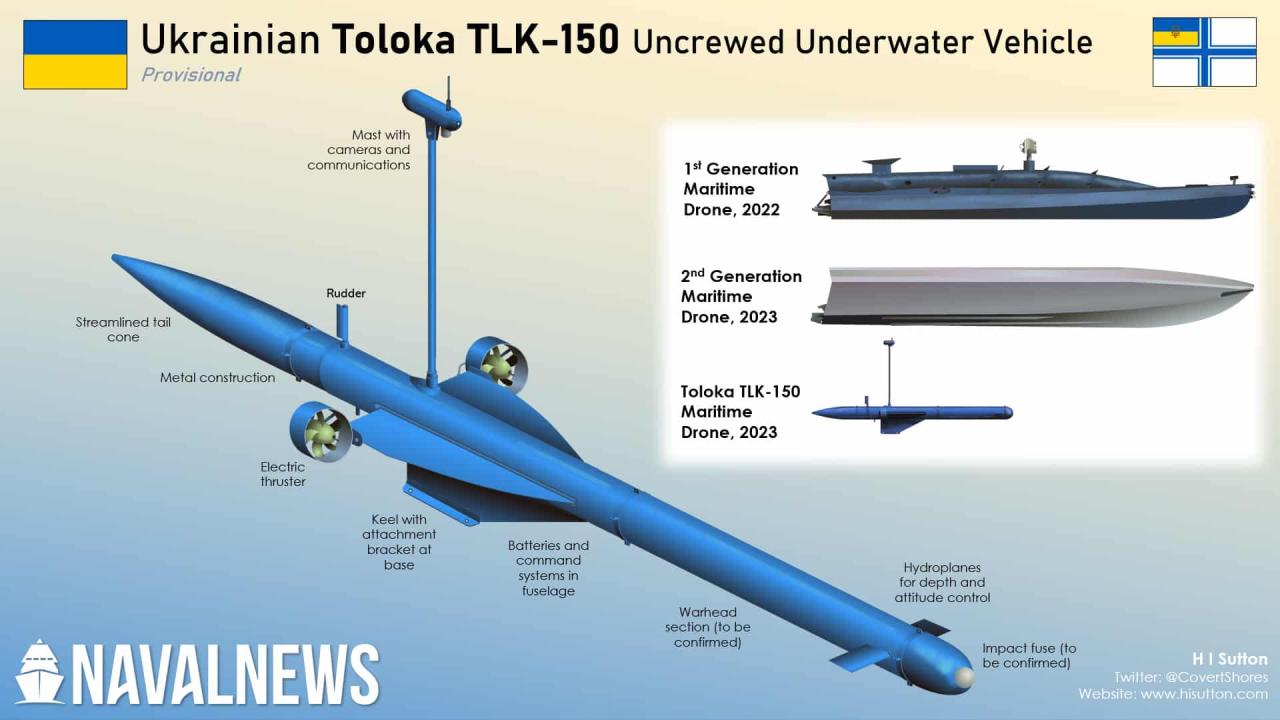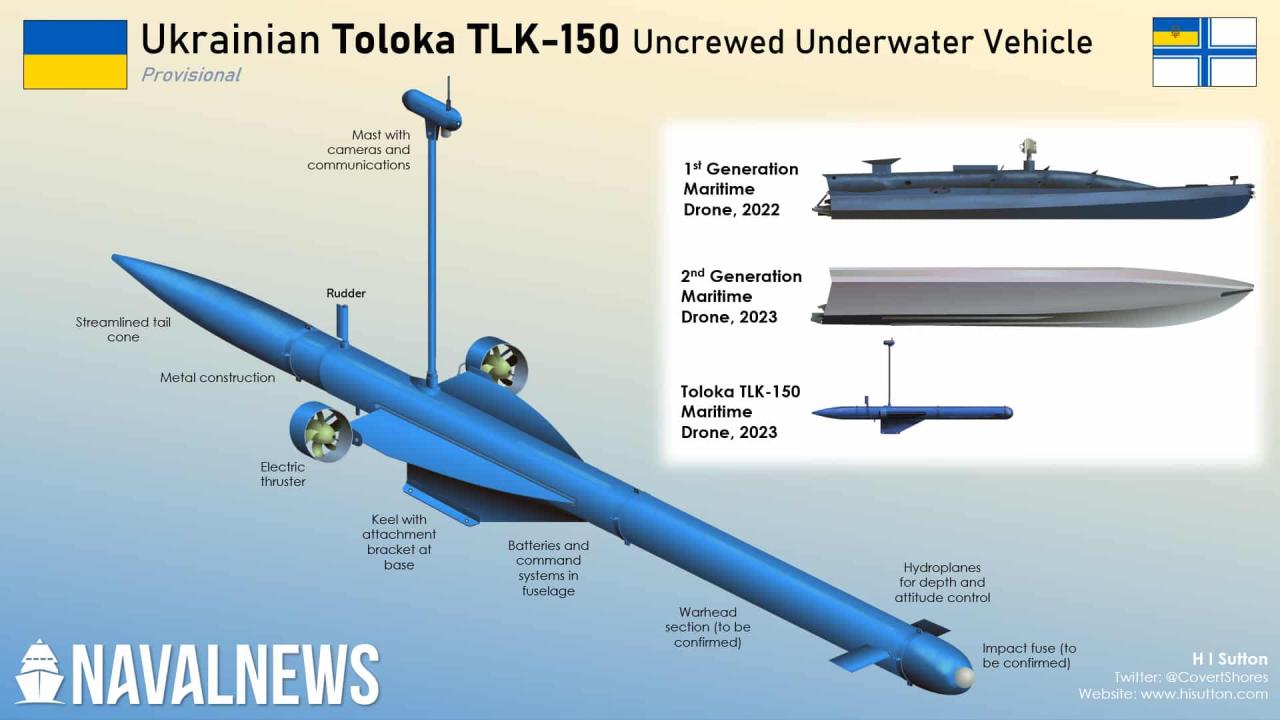Ukrainian sea drones are rapidly changing naval warfare. This exploration delves into their technology, operational use, impact, and future implications. We’ll examine their design, capabilities, and the logistical challenges of deploying them in conflict zones, comparing them to other nations’ similar technologies. Get ready to discover the fascinating world of these unmanned maritime vessels.
From their evolution and current capabilities to their tactical advantages and ethical considerations, we’ll cover it all. We’ll also explore the manufacturing process, cost-effectiveness, and potential for international collaboration in developing this cutting-edge technology. Prepare for a comprehensive look at this pivotal piece of modern military technology.
Ukrainian sea drones are making waves in naval warfare, showcasing innovative, smaller-scale tactics. It’s interesting to compare their military applications to the dazzling spectacle of a chinese new year drone dragon , a vibrant display of coordinated drone technology. Both highlight the versatility and potential of drone technology, though their purposes couldn’t be more different. Ultimately, the Ukrainian sea drone’s impact on naval strategy is a fascinating case study in modern warfare.
Ukrainian Sea Drone Technology

Ukraine’s development and deployment of sea drones represent a significant shift in naval warfare capabilities. This technology has evolved rapidly, offering a cost-effective and adaptable approach to maritime operations, particularly in asymmetric conflicts. This section will explore the current state, evolution, and comparison of Ukrainian sea drone technology with that of other nations.
Current State of Ukrainian Sea Drone Technology

Ukraine currently utilizes a range of sea drones, varying in size, payload capacity, and operational range. These drones are reportedly employed for reconnaissance, attack, and mine-laying operations. While specific details regarding their technical specifications remain classified, reports suggest a diverse fleet tailored to different mission profiles.
Evolution of Ukrainian Sea Drone Technology
The development of Ukrainian sea drone technology has likely been accelerated by the ongoing conflict. Initial designs were probably simpler, focusing on basic functionalities. Over time, improvements in autonomy, payload capacity, and navigation systems have likely occurred, driven by operational experience and technological advancements. The integration of more sophisticated sensors and communication systems is also probable.
Comparison with Other Nations’ Sea Drone Technology
Compared to larger, more established naval powers, Ukraine’s sea drone technology may be less sophisticated in terms of overall capabilities. However, its adaptability to asymmetric warfare, cost-effectiveness, and ease of deployment offer significant advantages. Ukraine’s approach emphasizes the strategic use of relatively inexpensive, expendable platforms, potentially offsetting the technological advantages of adversaries with larger, more expensive assets.
Specifications of Ukrainian Sea Drone Models
| Model | Speed (knots) | Payload (kg) | Range (km) |
|---|---|---|---|
| Model A (Hypothetical) | 10-15 | 50-100 | 50-100 |
| Model B (Hypothetical) | 5-10 | 200-300 | 200-300 |
| Model C (Hypothetical) | 20-25 | 20-50 | 100-150 |
Note: The above table presents hypothetical data as precise specifications for Ukrainian sea drones are not publicly available.
Operational Use of Ukrainian Sea Drones
Documented instances of Ukrainian sea drone usage in military operations highlight their tactical flexibility and effectiveness in various scenarios. Analyzing these deployments, alongside the inherent advantages and challenges, provides valuable insight into their operational impact.
Documented Uses in Military Operations
Reports suggest the use of Ukrainian sea drones in attacks against Russian naval vessels and infrastructure. These drones have reportedly been employed for reconnaissance missions, gathering intelligence on enemy movements and positions. Their effectiveness in disrupting enemy operations and inflicting damage, while minimizing risk to Ukrainian personnel, is a key aspect of their strategic value.
Tactical Advantages and Disadvantages
The advantages of sea drones include their low cost, ease of deployment, and ability to operate in challenging environments. Their small size and quiet operation make them difficult to detect and engage. However, disadvantages include limited payload capacity, vulnerability to electronic countermeasures, and reliance on effective communication and control systems.
Logistical Challenges in a Conflict Zone
Deploying and maintaining sea drones in a conflict zone presents significant logistical challenges. These include ensuring reliable communication links, securing supply chains for spare parts and fuel, and providing adequate training for operators. The operational environment, with its inherent risks and uncertainties, further complicates these logistical aspects.
Hypothetical Scenario: Swarm Attack

Imagine a scenario where a swarm of 20 smaller, less expensive Ukrainian sea drones is launched against a larger Russian naval vessel. These drones, equipped with explosives, approach the target from multiple directions, overwhelming the vessel’s defensive capabilities. The coordinated attack, exploiting the vessel’s blind spots, could inflict significant damage or even sink the target. The loss of a few drones in the process would be strategically acceptable, given the low cost of each unit and the high value of the target.
Impact and Implications of Ukrainian Sea Drones
The use of Ukrainian sea drones has had a noticeable impact on the ongoing conflict and holds significant geopolitical implications. Understanding these effects, alongside potential future applications and ethical considerations, is crucial for informed discussion.
Impact on the Ongoing Conflict
The deployment of sea drones has demonstrably altered the dynamics of naval warfare in the conflict. Their effectiveness in carrying out attacks against larger, more expensive vessels has shifted the balance of power, at least on a localized level. This has forced a reassessment of naval strategies and defense mechanisms by the opposing side.
Broader Geopolitical Implications
The success of Ukrainian sea drones has highlighted the potential for smaller nations and non-state actors to acquire and effectively utilize relatively inexpensive, yet impactful, military technologies. This has implications for future conflicts and the overall balance of power in global affairs. The technology’s affordability and ease of deployment could empower smaller nations or groups to project power beyond their traditional capabilities.
Potential Future Applications
The technology underlying Ukrainian sea drones has broad potential applications beyond military use. These include maritime surveillance, environmental monitoring, underwater infrastructure inspection, and search and rescue operations. The adaptability of this technology across various sectors suggests a wide range of future developments.
Ethical Concerns
- Autonomous targeting and the potential for civilian casualties.
- The lack of human oversight in decision-making during attacks.
- The potential for proliferation of this technology to non-state actors.
- The risk of escalation and unintended consequences in armed conflicts.
Technological Aspects of Ukrainian Sea Drones
Understanding the technological components, navigation systems, and potential use of AI in Ukrainian sea drones provides insight into their capabilities and future development. A simplified illustration helps visualize these key elements.
Technological Components
A typical Ukrainian sea drone likely incorporates several key components: a robust hull designed for marine environments, a propulsion system (likely electric for quieter operation), a payload bay for carrying explosives or sensors, communication systems for data transmission and control, and a navigation and guidance system.
Navigation and Guidance Systems
These drones likely utilize a combination of GPS, inertial navigation systems (INS), and potentially other sensor data for precise navigation. The guidance system would incorporate algorithms for path planning, obstacle avoidance, and target acquisition. Integration with satellite imagery or other intelligence data for target location and tracking is probable.
AI and Machine Learning
While the extent of AI integration is unclear, future iterations of Ukrainian sea drones may incorporate AI for autonomous navigation, target recognition, and decision-making. Machine learning algorithms could enhance the drone’s ability to adapt to changing environments and improve its effectiveness in various scenarios.
Ukrainian sea drones are causing a stir, proving their effectiveness in naval warfare. Their innovative designs are inspiring interest from unexpected corners, even influencing the work of South Korean actor lee byung-hun , who’s exploring similar themes of technological advancement in his latest project. The impact of these drones on future naval strategies is undeniable and continues to evolve rapidly.
Diagram of Internal Structure
Imagine a cross-sectional diagram showing the internal structure of a sea drone. The diagram would depict the hull, the propulsion system (electric motor and propeller), the battery pack, the payload bay (containing explosives or sensors), the control unit (housing the computer and communication systems), and the various sensors (GPS, INS, cameras, etc.). Each component would be clearly labeled. The diagram would visually represent the compact and efficient design of these drones.
Manufacturing and Procurement of Ukrainian Sea Drones
The manufacturing and procurement processes, key players, cost-effectiveness, and potential for international collaboration are all crucial factors in understanding the broader context of Ukrainian sea drone technology.
Manufacturing and Procurement Process
The exact details of the manufacturing and procurement process remain largely undisclosed for security reasons. However, it’s likely that a combination of state-owned and private entities are involved in the design, production, and supply of these drones. The process likely involves rapid prototyping, testing, and iterative improvements driven by the operational needs of the conflict.
Key Players
While specific companies and individuals are not publicly identified, it is likely that Ukrainian defense industries, research institutions, and potentially international partners play a role in the development and production of these drones. The collaboration might involve technology transfer, component supply, and expertise sharing.
Cost-Effectiveness Compared to Traditional Vessels

Sea drones offer a significant cost advantage compared to traditional naval vessels. Their lower production and operational costs allow for deployment of larger numbers, making them a more cost-effective approach to asymmetric warfare. This cost-effectiveness is a major factor in their strategic appeal.
Potential for International Collaboration
The success of Ukrainian sea drones has likely attracted interest from other nations seeking cost-effective and adaptable naval capabilities. International collaboration in the development and production of this technology could lead to further advancements and wider adoption. This collaboration could involve technology sharing, joint development projects, and the establishment of supply chains.
Ukrainian sea drones are making waves, literally, with their innovative designs and potential impact on naval warfare. Thinking about the scale of potential damage, it’s interesting to compare this to other types of unexpected disasters; for instance, the impact of the jeju air crash highlighted the devastating consequences of unforeseen events. Returning to the subject of Ukrainian sea drones, their future development and deployment will be fascinating to watch.
Conclusive Thoughts: Ukrainian Sea Drone
Ukrainian sea drones represent a significant shift in naval power dynamics. Their cost-effectiveness, adaptability, and potential for swarm tactics offer compelling advantages in modern warfare. While ethical concerns and logistical challenges remain, the ongoing development and deployment of this technology will undoubtedly continue to shape future naval strategies and geopolitical landscapes. The future of naval warfare may well be unmanned.
FAQ Overview
What materials are typically used in Ukrainian sea drone construction?
Common materials include fiberglass, carbon fiber, and various types of durable plastics chosen for their lightweight, strength, and corrosion resistance in a marine environment.
How are Ukrainian sea drones powered?
Power sources vary depending on the drone’s size and mission, but common options include rechargeable batteries, fuel cells, or even small internal combustion engines.
What is the lifespan of a Ukrainian sea drone?
Lifespan depends on usage, maintenance, and environmental factors. However, components will require regular replacement, impacting overall operational lifespan.
How are Ukrainian sea drones equipped for communication?
They typically utilize various communication systems, including satellite links, radio frequencies, and potentially underwater acoustic communication for extended range and submerged operations.
